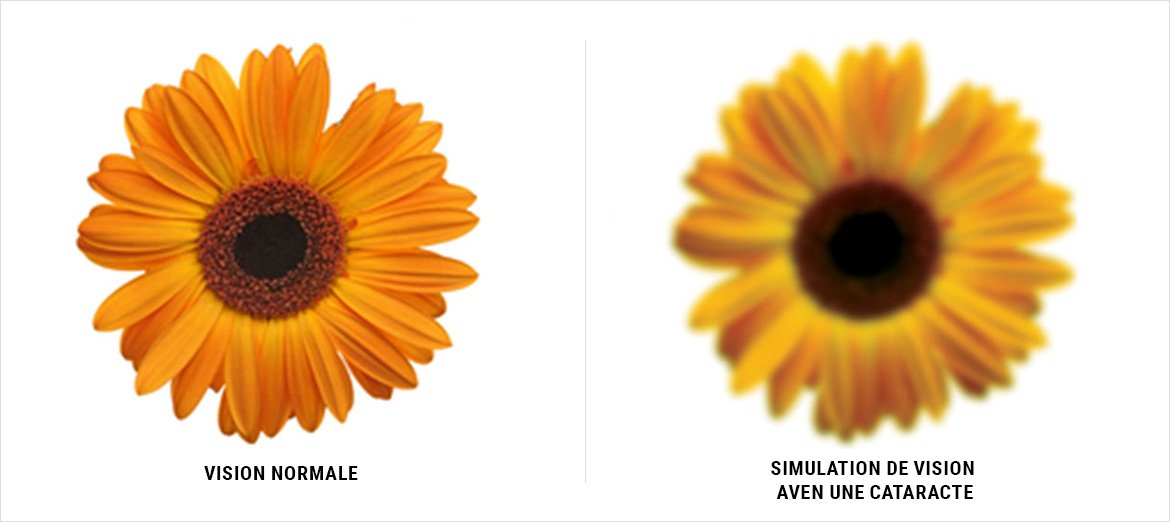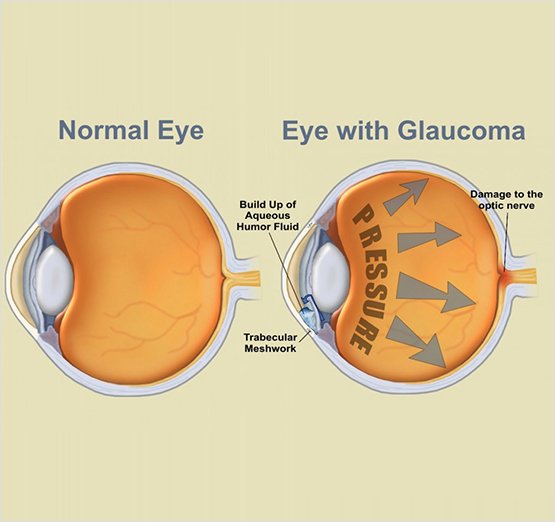Eye Health
Cataract

CATARACT is clouding of the lens in the eye that affects vision. A cataract can occur in either or both eyes.
The lens lies behind the iris and the pupil. It works much like a camera lens. It focuses light onto the retina at the back of the eye, where an image is recorded. The lens also adjusts the eye's focus, letting us see things clearly both up close and far away. The lens is made of mostly water and protein.The protein is arranged in a precise way that keeps the lens clear and allows the light to pass through it.
But as we age, some of the protein may clump together and start to cloud a small area of the lens. This is a cataract. The lens must be clear for the retina to receive a sharp image. If the lens is cloudy from a cataract, the image you see will blur.
Risk for cataract increases as we grow older. Other risk factors include certain diseases like diabetes, smoking and alcohol use, prolonged exposure to sunlight.
Symptoms of Cataracts
- Vision that is cloudy, blurry, foggy, or filmy.
- Problems with glare during the day.
- Double vision (like a superimposed image).
- Sudden changes in glasses prescription.
- Problems driving at night such as glare from oncoming headlights.
- Changes in the way you see color because the discolored lens acts as a filter.
- Progressive nearsightedness in older people often called "second sight" because they may no longer need reading glasses.
Wearing sunglasses and a hat with a brim to block ultraviolet sunlight may help to delay cataract. If you smoke, stop. Researchers also believe good nutrition can help reduce the risk of age-related cataract. They recommend eating green leafy vegetables, fruit, and other foods with antioxidants.
If you are of age 60 years or older, you should have a comprehensive dilated eye exam at least once every two years. In addition to cataract, your eye care professional can check for signs of age-related macular degeneration, glaucoma, and other vision disorders. Early treatment for many eye diseases may save your sight.

Glaucoma
Glaucoma is a disease of the eye in which fluid pressure within the eye rises. If left untreated, the patient may lose vision. It is a complicated disease in which increased pressure can damage the optics nerve of the eye, leading to progressive, irreversible vision loss.
Symptoms of Glaucoma
- Extreme Headache
- Distorted Vision
- Eye redness
- Severe eye pain
- Vomiting
- Halos around the light
If you are over the age of 40 years and if you have a family history of glaucoma, you should have a complete eye exam with an eye doctor every one to two years. If you have health problems such as diabetes or a family history of glaucoma or are at risk for other eye diseases, you may need to visit your eye doctor more frequently.

Eye and UV Protection
Studies have shown that prolonged exposure to the sun can lead to cataract, growth on the eye like pterygium, macular degeneration and even cancer. Diseases like cataract and eye cancers can take many years to develop, but each time we're out in the sun without protection, we could be adding damage that adds to our risks for these serious disorders.
Babies and kids need to wear hats and sunglasses for this very reason. People of all ages should take precautions whenever they are outdoors.
UV rays can come from many directions. They radiate directly from the sun, but they are also reflected from the ground, from water, snow, sand and other bright surfaces.
The risk of sun-related eye problem are higher in people who spend long hours in the sun, who have cataract surgery done and also people who are under certain medicines like sulfa drugs, birth control pills, tetracylin diuretics that increases the eye’s sensitivity to light.

Protection from UV
- Sunglasses with 100% UV blocking.
- Photo-chromatic lenses.
- Contact lenses and IOL lenses are also available with UV protection.
- A brimmed hat or cap can also limit UV rays that hit the eyes from above or around glasses.
For UV protection in everyday eyewear, there are several options like UV-blocking lens materials, coatings and photo-chromatic lenses. UV protection does not cost a lot of money and does not get in the way of seeing clearly.
ASK our Optometrist for best UV protection options available.
Computer Vision Syndrome (CVS)

CVS is not one specific eye problem. Instead, the term encompasses a whole range of eyestrain and pain experienced by computer users.
All of these functions require a lot of effort from the eye muscles. Working on a computer is more challenging to your eyes than reading a book or piece of paper, because a computer screen also adds the elements of screen contrast, flicker, and glare.
Computer eye problems are more likely to occur if you already have an eye problem - such as nearsightedness or astigmatism - or if you need glasses but don't wear them or wear the wrong prescription for computer use.
Symptoms of CVS
- Double vision
- Blurred vision
- Dry, red eyes
- Eye irritation
- Headaches
- Neck or back pain
Simple steps for Relief
- Keep Blinking : This keeps our eye moist and lubricated.
- Remember 20-20-20 : Every 20 minutes, spend 20 seconds looking at something 20 feet away, minimum.
- Wear Computer Glasses : Wearing your appropriate corrective glasses will reduce your eye strain.
- Lubricating eye drops to reduce the symptoms of dry eyes.
- Comfortable Chair : Make sure your seat is comfortable. A comfortable chair with support for your neck and back will help you avoid neck and shoulder strain commonly associated with Computer Vision Syndrome.
- Right Light : Position the computer screen to reduce reflection from windows and overhead light. Keep the desk lamps shinning on your desk, not on you.
- Adjust your Monitor : Keep it at least 20 inches from your eyes Adjust the screen so that you look at it slightly below the eye level. Adjust the screen settings to where they are comfortable — contract polarity, resolution, flicker, etc. Adjust the right brightness and contrast of your screen.
For more information on Computer Vision Syndrome, talk to our Optometrist.
Age and Eyesight
-
Parents and Pregnancy
The body goes through many changes during pregnancy and the eyes can be affected. Eyes may change somewhat during pregnancy due to fluid retention, increased blood volume, hormonal fluctuations and other physical shifts that are part of pregnancy. Usually these changes are temporary and resolve after the baby is born. Vision changes tend to be minor and don’t require a new eyeglass prescription. A condition known as dry eye may result from hormonal fluctuations. Wearing contact lenses may be less comfortable when dry eye is present.
-
Toddler and early School Years
It is important to get your child’s baseline eye evaluation done by your eye care professional early in life. This is especially important if you have any family history of eye problem. Your child may not be old enough to read a vision chart but that shouldn’t stop you from getting his eyes checked. One out of every four children has an undetected vision problem - learn the tell-tale sign. Because children learn so much through their eyes, good vision is very important.
-
Teenagers and Youngsters
Uncorrected vision problems can affect all aspects of a young person’s life as they make the step into adulthood. It is therefore very important to get an annual eye examination done. Also since it’s their growing age, the prescription tends to show frequent changes. Protective glasses are also advisable to worn during sport activities.

Over 40s
Your near vision starts to worsen around the age of 40. This is called presbyopia. Beginning in the early to mid-forties, most adults may start to experience problems with their ability to see clearly at close distances, especially for reading and computer tasks. This normal aging change in the eye's focusing ability, will continue to progress over time. Initially, you may find you need to hold reading materials farther away to see them clearly. Print in the newspaper or on a restaurant menu may appear blurred, especially under dim lighting. Fortunately, people with presbyopia now have many options to obtain clear, comfortable near vision for all their life style needs. The options include eyeglasses, contact lenses and surgical correction. Some of the other common eye problems and diseases after we reach 40 years of age are cataracts, glaucoma, diabetic retinopathy, etc.

Over 60s
Regular eye examinations are important at this age to help you get the best out of life. In older people, the macula – the centre of the retina which is used for detailed vision – thins and occasionally bleeds. This can lead to distortion of, or even the loss of, central vision. The sufferer may also have trouble discerning colors. Peripheral vision remains unaffected, but central vision loss is serious, so early diagnosis and treatment is vital. Tiny ‘spots’ or ‘blobs’ in the field or vision are often just harmless clusters of cells and will disappear without worry. If they persist, it is worth checking with an eye care professional. it might be early sign of retinal detachment. An annual eye exam can help catch devastating eye diseases, like glaucoma and macular degeneration, early. Early detection increases the chances of maintaining healthy vision.
© Copyright 2017 Vision Nexgen
